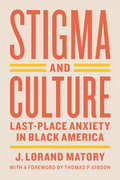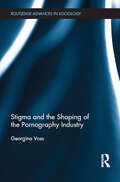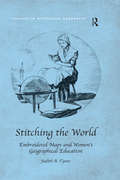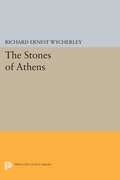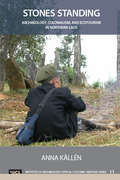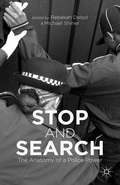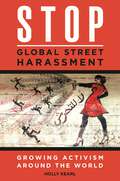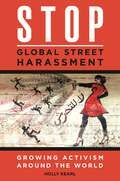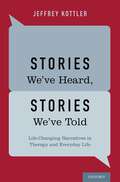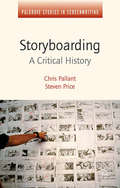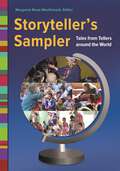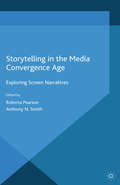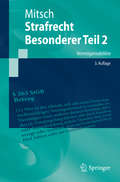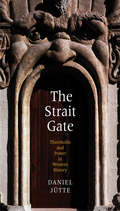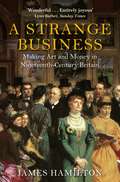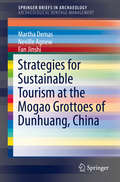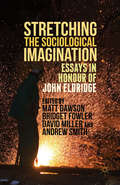- Table View
- List View
Stigma and Culture: Last-Place Anxiety in Black America (Lewis Henry Morgan Lecture Series)
by J. Lorand MatoryIn Stigma and Culture, J. Lorand Matory provocatively shows how ethnic identification in the United States—and around the globe—is a competitive and hierarchical process in which populations, especially of historically stigmatized races, seek status and income by dishonoring other stigmatized populations. And there is no better place to see this than among the African American elite in academia, where he explores the emergent ethnic identities of African and Caribbean immigrants and transmigrants, Gullah/Geechees, Louisiana Creoles, and even Native Americans of partly African ancestry. Matory describes the competitive process that hierarchically structures their self-definition as ethnic groups and the similar process by which middle-class African Americans seek distinction from their impoverished compatriots. Drawing on research at universities such as Howard, Harvard, and Duke and among their alumni networks, he details how university life—while facilitating individual upward mobility, touting human equality, and regaling cultural diversity—also perpetuates the cultural standards that historically justified the dominance of some groups over others. Combining his ethnographic findings with classic theoretical insights from Frantz Fanon, Fredrik Barth, Erving Goffman, Pierre Bourdieu and others—alongside stories from his own life in academia—Matory sketches the university as an institution that, particularly through the anthropological vocabulary of culture, encourages the stigmatized to stratify their own.
Stigma and Culture: Last-Place Anxiety in Black America (Lewis Henry Morgan Lecture Series)
by J. Lorand MatoryIn Stigma and Culture, J. Lorand Matory provocatively shows how ethnic identification in the United States—and around the globe—is a competitive and hierarchical process in which populations, especially of historically stigmatized races, seek status and income by dishonoring other stigmatized populations. And there is no better place to see this than among the African American elite in academia, where he explores the emergent ethnic identities of African and Caribbean immigrants and transmigrants, Gullah/Geechees, Louisiana Creoles, and even Native Americans of partly African ancestry. Matory describes the competitive process that hierarchically structures their self-definition as ethnic groups and the similar process by which middle-class African Americans seek distinction from their impoverished compatriots. Drawing on research at universities such as Howard, Harvard, and Duke and among their alumni networks, he details how university life—while facilitating individual upward mobility, touting human equality, and regaling cultural diversity—also perpetuates the cultural standards that historically justified the dominance of some groups over others. Combining his ethnographic findings with classic theoretical insights from Frantz Fanon, Fredrik Barth, Erving Goffman, Pierre Bourdieu and others—alongside stories from his own life in academia—Matory sketches the university as an institution that, particularly through the anthropological vocabulary of culture, encourages the stigmatized to stratify their own.
Stigma and Culture: Last-Place Anxiety in Black America (Lewis Henry Morgan Lecture Series)
by J. Lorand MatoryIn Stigma and Culture, J. Lorand Matory provocatively shows how ethnic identification in the United States—and around the globe—is a competitive and hierarchical process in which populations, especially of historically stigmatized races, seek status and income by dishonoring other stigmatized populations. And there is no better place to see this than among the African American elite in academia, where he explores the emergent ethnic identities of African and Caribbean immigrants and transmigrants, Gullah/Geechees, Louisiana Creoles, and even Native Americans of partly African ancestry. Matory describes the competitive process that hierarchically structures their self-definition as ethnic groups and the similar process by which middle-class African Americans seek distinction from their impoverished compatriots. Drawing on research at universities such as Howard, Harvard, and Duke and among their alumni networks, he details how university life—while facilitating individual upward mobility, touting human equality, and regaling cultural diversity—also perpetuates the cultural standards that historically justified the dominance of some groups over others. Combining his ethnographic findings with classic theoretical insights from Frantz Fanon, Fredrik Barth, Erving Goffman, Pierre Bourdieu and others—alongside stories from his own life in academia—Matory sketches the university as an institution that, particularly through the anthropological vocabulary of culture, encourages the stigmatized to stratify their own.
Stigma and Culture: Last-Place Anxiety in Black America (Lewis Henry Morgan Lecture Series)
by J. Lorand MatoryIn Stigma and Culture, J. Lorand Matory provocatively shows how ethnic identification in the United States—and around the globe—is a competitive and hierarchical process in which populations, especially of historically stigmatized races, seek status and income by dishonoring other stigmatized populations. And there is no better place to see this than among the African American elite in academia, where he explores the emergent ethnic identities of African and Caribbean immigrants and transmigrants, Gullah/Geechees, Louisiana Creoles, and even Native Americans of partly African ancestry. Matory describes the competitive process that hierarchically structures their self-definition as ethnic groups and the similar process by which middle-class African Americans seek distinction from their impoverished compatriots. Drawing on research at universities such as Howard, Harvard, and Duke and among their alumni networks, he details how university life—while facilitating individual upward mobility, touting human equality, and regaling cultural diversity—also perpetuates the cultural standards that historically justified the dominance of some groups over others. Combining his ethnographic findings with classic theoretical insights from Frantz Fanon, Fredrik Barth, Erving Goffman, Pierre Bourdieu and others—alongside stories from his own life in academia—Matory sketches the university as an institution that, particularly through the anthropological vocabulary of culture, encourages the stigmatized to stratify their own.
Stigma and Culture: Last-Place Anxiety in Black America (Lewis Henry Morgan Lecture Series)
by J. Lorand MatoryIn Stigma and Culture, J. Lorand Matory provocatively shows how ethnic identification in the United States—and around the globe—is a competitive and hierarchical process in which populations, especially of historically stigmatized races, seek status and income by dishonoring other stigmatized populations. And there is no better place to see this than among the African American elite in academia, where he explores the emergent ethnic identities of African and Caribbean immigrants and transmigrants, Gullah/Geechees, Louisiana Creoles, and even Native Americans of partly African ancestry. Matory describes the competitive process that hierarchically structures their self-definition as ethnic groups and the similar process by which middle-class African Americans seek distinction from their impoverished compatriots. Drawing on research at universities such as Howard, Harvard, and Duke and among their alumni networks, he details how university life—while facilitating individual upward mobility, touting human equality, and regaling cultural diversity—also perpetuates the cultural standards that historically justified the dominance of some groups over others. Combining his ethnographic findings with classic theoretical insights from Frantz Fanon, Fredrik Barth, Erving Goffman, Pierre Bourdieu and others—alongside stories from his own life in academia—Matory sketches the university as an institution that, particularly through the anthropological vocabulary of culture, encourages the stigmatized to stratify their own.
Stigma and Culture: Last-Place Anxiety in Black America (Lewis Henry Morgan Lecture Series)
by J. Lorand MatoryIn Stigma and Culture, J. Lorand Matory provocatively shows how ethnic identification in the United States—and around the globe—is a competitive and hierarchical process in which populations, especially of historically stigmatized races, seek status and income by dishonoring other stigmatized populations. And there is no better place to see this than among the African American elite in academia, where he explores the emergent ethnic identities of African and Caribbean immigrants and transmigrants, Gullah/Geechees, Louisiana Creoles, and even Native Americans of partly African ancestry. Matory describes the competitive process that hierarchically structures their self-definition as ethnic groups and the similar process by which middle-class African Americans seek distinction from their impoverished compatriots. Drawing on research at universities such as Howard, Harvard, and Duke and among their alumni networks, he details how university life—while facilitating individual upward mobility, touting human equality, and regaling cultural diversity—also perpetuates the cultural standards that historically justified the dominance of some groups over others. Combining his ethnographic findings with classic theoretical insights from Frantz Fanon, Fredrik Barth, Erving Goffman, Pierre Bourdieu and others—alongside stories from his own life in academia—Matory sketches the university as an institution that, particularly through the anthropological vocabulary of culture, encourages the stigmatized to stratify their own.
Stigma and the Shaping of the Pornography Industry (Routledge Advances in Sociology)
by Georgina VossThe idea of ‘pornography’ is often employed to invoke titillation, anger, and disgust. Stigma and the Shaping of the Pornography Industry explores the effects that this stigmatized identity has on the pornography industry itself. From the video era to the emergence of the internet, to trade shows, white-collar workers, technological innovation, and industry-wide characteristics, this book looks beyond content production to explore how stigma has shaped the structures, practices, norms, and boundaries of the wider sector. By drawing on concepts such as dirty work, core-stigmatized industries, and outlaw innovation, this book offers rich insights into the ways in which stigma is socially constructed and managed, and the deep structural effects that it has on the industry.
Stigma and the Shaping of the Pornography Industry (Routledge Advances in Sociology)
by Georgina VossThe idea of ‘pornography’ is often employed to invoke titillation, anger, and disgust. Stigma and the Shaping of the Pornography Industry explores the effects that this stigmatized identity has on the pornography industry itself. From the video era to the emergence of the internet, to trade shows, white-collar workers, technological innovation, and industry-wide characteristics, this book looks beyond content production to explore how stigma has shaped the structures, practices, norms, and boundaries of the wider sector. By drawing on concepts such as dirty work, core-stigmatized industries, and outlaw innovation, this book offers rich insights into the ways in which stigma is socially constructed and managed, and the deep structural effects that it has on the industry.
Stitching the World: Embroidered Maps And Women's Geographical Education (Studies in Historical Geography)
by Judith A. TynerFrom the late eighteenth century until about 1840, schoolgirls in the British Isles and the United States created embroidered map samplers and even silk globes. Hundreds of British maps were made and although American examples are more rare, they form a significant collection of artefacts. Descriptions of these samplers stated that they were designed to teach needlework and geography. The focus of this book is not on stitches and techniques used in 'drafting' the maps, but rather why they were developed, how they diffused from the British Isles to the United States, and why they were made for such a brief time. The events of the late eighteenth and early nineteenth centuries stimulated an explosion of interest in geography. The American and French Revolutions, the wars between France and England, the War of 1812, Captain Cook's voyages, and the explorations of Lewis and Clark made the study of places exciting and important. Geography was the first science taught to girls in school. This period also coincided with major changes in educational theories and practices, especially for girls, and this book uses needlework maps and globes to chart a broader discussion of women's geographic education. In this light, map samplers and embroidered globes represent a transition in women's education from 'accomplishments' in the eighteenth century to challenging geographic education and conventional map drawing in schools and academies of the second half of the nineteenth century. There has been little serious study of these maps by cartographers and, moreover, historians of cartography have largely neglected the role of women in mapping. Children's maps have not been studied, although they might have much to offer about geographical teaching and perceptions of a period, and map samplers have been dismissed because they are the work of schoolgirls. Needlework historians, likewise, have not done in depth studies of map samplers until recently. Stitching the World is an interdisciplinary work drawing on cartography, needlework, and material culture. This book for the first time provides a critical analysis of these artefacts, showing that they offer significant insights into both eighteenth- and nineteenth-century geographic thought and cartography in the USA and the UK and into the development of female education.
Stitching the World: Embroidered Maps and Women’s Geographical Education (Studies in Historical Geography)
by Judith A. TynerFrom the late eighteenth century until about 1840, schoolgirls in the British Isles and the United States created embroidered map samplers and even silk globes. Hundreds of British maps were made and although American examples are more rare, they form a significant collection of artefacts. Descriptions of these samplers stated that they were designed to teach needlework and geography. The focus of this book is not on stitches and techniques used in 'drafting' the maps, but rather why they were developed, how they diffused from the British Isles to the United States, and why they were made for such a brief time. The events of the late eighteenth and early nineteenth centuries stimulated an explosion of interest in geography. The American and French Revolutions, the wars between France and England, the War of 1812, Captain Cook's voyages, and the explorations of Lewis and Clark made the study of places exciting and important. Geography was the first science taught to girls in school. This period also coincided with major changes in educational theories and practices, especially for girls, and this book uses needlework maps and globes to chart a broader discussion of women's geographic education. In this light, map samplers and embroidered globes represent a transition in women's education from 'accomplishments' in the eighteenth century to challenging geographic education and conventional map drawing in schools and academies of the second half of the nineteenth century. There has been little serious study of these maps by cartographers and, moreover, historians of cartography have largely neglected the role of women in mapping. Children's maps have not been studied, although they might have much to offer about geographical teaching and perceptions of a period, and map samplers have been dismissed because they are the work of schoolgirls. Needlework historians, likewise, have not done in depth studies of map samplers until recently. Stitching the World is an interdisciplinary work drawing on cartography, needlework, and material culture. This book for the first time provides a critical analysis of these artefacts, showing that they offer significant insights into both eighteenth- and nineteenth-century geographic thought and cartography in the USA and the UK and into the development of female education.
The Stones of Athens
by Richard Ernest WycherleyInterpreting the monuments of Athens in light of literature, R. E. Wycherley brings before us the city the ancients knew. Philosophers, statesmen, travelers, dramatists, poets, private citizens—the words of all these suggest how the city looked at various periods, how its monuments came to be built, and how they served the people in daily life. Professor Wycherley concentrates on the classical period, illustrating his work with plans, reconstructions, and photographs.Originally published in 1978.The Princeton Legacy Library uses the latest print-on-demand technology to again make available previously out-of-print books from the distinguished backlist of Princeton University Press. These editions preserve the original texts of these important books while presenting them in durable paperback and hardcover editions. The goal of the Princeton Legacy Library is to vastly increase access to the rich scholarly heritage found in the thousands of books published by Princeton University Press since its founding in 1905.
Stones Standing: Archaeology, Colonialism, and Ecotourism in Northern Laos (UCL Institute of Archaeology Critical Cultural Heritage Series)
by Anna KällénThis book is an inquiry into the relationships between archaeology, colonialism and ecotourism at the famous standing stones of Hintang, Laos. It investigates the conditions under which archaeological knowledge has been produced, appropriated, contested, commodified, and consumed by colonialism from the 1930s until today and what it shows about the power dynamics of heritage and ecotourism. The volume-explores how the discourses of colonialism and ecotourism affect tourists, archaeologists, heritage managers, and the local community;-is written as a set of overlapping creative essays, each giving an overlapping perspective on Hintang;-is a multidisciplinary research project based on ethnographic fieldwork, archival research, interviews with community members, biography, material culture studies, and text analysis.
Stones Standing: Archaeology, Colonialism, and Ecotourism in Northern Laos (UCL Institute of Archaeology Critical Cultural Heritage Series)
by Anna KällénThis book is an inquiry into the relationships between archaeology, colonialism and ecotourism at the famous standing stones of Hintang, Laos. It investigates the conditions under which archaeological knowledge has been produced, appropriated, contested, commodified, and consumed by colonialism from the 1930s until today and what it shows about the power dynamics of heritage and ecotourism. The volume-explores how the discourses of colonialism and ecotourism affect tourists, archaeologists, heritage managers, and the local community;-is written as a set of overlapping creative essays, each giving an overlapping perspective on Hintang;-is a multidisciplinary research project based on ethnographic fieldwork, archival research, interviews with community members, biography, material culture studies, and text analysis.
Stop and Search: The Anatomy of a Police Power (Routledge Frontiers Of Criminal Justice Ser.)
by Rebekah DelsolThis book reviews the key controversies surrounding the police power to stop and search members of the public. It explores the history and development of these powers, assesses their effectiveness in tackling crime and their impact on public trust and confidence as well as on-going attempts at regulation and reform.
Stop Global Street Harassment: Growing Activism around the World
by Holly KearlOnce a largely dismissed problem, street harassment is now headline news and being addressed by many international agencies and governments worldwide. This book details how a growing number of individuals, small groups, international organizations, and government agencies worldwide are working to create safe public spaces.Everyone should be able to navigate through public spaces without facing harassment or the threat of sexual assault, yet that is a right that millions of people worldwide are routinely denied. In the United States alone, 65 percent of women and 25 percent of men experience street harassment. This book taps personal stories, research data, news stories, and information about global campaigns and grassroots action in dozens of countries to trace the growing social movement to recognize, address, and prevent street harassment. The author suggests what steps need to be taken next to help stop street harassment globally and invites readers to take action and be part of the solution.The book addresses specific and prominent incidents of street harassment such as the mass sexual assaults of women at Tahrir Square in Cairo, Egypt; the gang rape and murder of a young woman on a bus in Delhi, India, in 2012; and the viral hidden-camera video produced by Hollaback!, an advocacy group dedicated to ending street harassment, that documents the catcalling and stalking that happens to a woman as she walks through New York City. It documents the explosion of studies, personal story sharing, grassroots campaigns, and media attention on street harassment since 2010 as well as Global Safe Cities efforts by international organizations like UN Women and ActionAid in countries on all six continents during that time period. Attention is also paid to the ongoing lack of enforcement of laws on street harassment by police and judges. The book concludes by looking forward at remedies for the problem: education among youth about street harassment and addressing issues of consent and respect.
Stop Global Street Harassment: Growing Activism around the World
by Holly KearlOnce a largely dismissed problem, street harassment is now headline news and being addressed by many international agencies and governments worldwide. This book details how a growing number of individuals, small groups, international organizations, and government agencies worldwide are working to create safe public spaces.Everyone should be able to navigate through public spaces without facing harassment or the threat of sexual assault, yet that is a right that millions of people worldwide are routinely denied. In the United States alone, 65 percent of women and 25 percent of men experience street harassment. This book taps personal stories, research data, news stories, and information about global campaigns and grassroots action in dozens of countries to trace the growing social movement to recognize, address, and prevent street harassment. The author suggests what steps need to be taken next to help stop street harassment globally and invites readers to take action and be part of the solution.The book addresses specific and prominent incidents of street harassment such as the mass sexual assaults of women at Tahrir Square in Cairo, Egypt; the gang rape and murder of a young woman on a bus in Delhi, India, in 2012; and the viral hidden-camera video produced by Hollaback!, an advocacy group dedicated to ending street harassment, that documents the catcalling and stalking that happens to a woman as she walks through New York City. It documents the explosion of studies, personal story sharing, grassroots campaigns, and media attention on street harassment since 2010 as well as Global Safe Cities efforts by international organizations like UN Women and ActionAid in countries on all six continents during that time period. Attention is also paid to the ongoing lack of enforcement of laws on street harassment by police and judges. The book concludes by looking forward at remedies for the problem: education among youth about street harassment and addressing issues of consent and respect.
Stories We've Heard, Stories We've Told: Life-Changing Narratives in Therapy and Everyday Life
by Jeffrey KottlerThis is a book that integrates what is known from a wide variety of disciplines about the nature of storytelling and how it influences and transforms people's lives. Drawing on material from the humanities, sociology, anthropology, neurophysiology, media and communication studies, narrative inquiry, indigenous healing traditions, as well as education, counseling, and therapy, the book explores the ways that therapists operate as professional storytellers. In addition, our job is to hold and honor the stories of our clients, helping them to reshape them in more constructive ways. The book itself is written as a story, utilizing engaging prose, research, photographs, and powerful anecdotes to draw readers into the intriguing dynamics and processes involved in therapeutic storytelling. It sets the stage for what follows by discussing the ways that stories have influenced history, cultural development, and individual worldviews and then delves into the ways that everyday lives are impacted by the stories we hear, read, and view in popular media. The focus then moves to stories within the context of therapy, exploring how client stories are told, heard, and negotiated in sessions. Attention then moves to the ways that therapists can become more skilled and accomplished storytellers, regardless of their theoretical preferences and style.
Storyboarding: A Critical History (Palgrave Studies in Screenwriting)
by Steven Price Chris PallantThis study provides the first book-length critical history of storyboarding, from the birth of cinema to the present day and beyond. It discusses the role of storyboarding in key films including Gone with the Wind , Psycho and The Empire Strikes Back , and is illustrated with a wide range of images.
Storyteller's Sampler: Tales from Tellers around the World
by Margaret Read MacDonaldLooking for fresh ideas to liven up your storytimes? Here you'll find a wonderfully diverse collection of easy-to-tell tales from around the world, along with tips and profiles of the storytellers featured in the book.Ideal for educators and others who work with young children, these stories have been selected because they are easy for anyone to tell, even novices, and they readily engage listeners. Along with each tale, you'll find a profile of the "teller" who provides it, adding a cultural dimension to help you and your audiences better understand the context. There are also tips to improve your programs.In addition to storytimes, this guide can be used for read-alouds, or even silent reading with older children. Whether you are a librarian, educator, or parent, Storyteller's Sampler: Tales from Tellers around the World will help you keep children entertained—all while encouraging their learning and development.
Storytelling in the Media Convergence Age: Exploring Screen Narratives
by Roberta Pearson Anthony N. SmithWhy do screen narratives remain so different in an age of convergence and globalisation that many think is blurring distinctions? This collection attempts to answer this question using examples drawn from a range of media, from Hollywood franchises to digital comics, and a range of countries, from the United States to Japan
Strafrecht, Besonderer Teil 2: Vermögensdelikte (Springer-Lehrbuch)
by Wolfgang MitschDieses Lehrbuch informiert umfassend über die examensrelevanten Straftatbestände des StGB, die Vermögen, Eigentum oder sonstige Vermögensgüter schützen. Der Text bereitet den Stoff systematisch auf und hebt dabei schwierige und umstrittene Einzelfragen durch ausführliche Darstellung der dazu vertretenen Meinungen deutlich hervor. Unterstützt wird der Lernprozess mittels zahlreicher Fallbeispiele mit Lösungshinweisen, die dem Benutzer Gelegenheit zu aktiven Übungen an Strafrechtsfällen geben. Der Leser sollte daher zunächst versuchen, die Fälle selbst zu lösen und danach den Text weiter lesen. Auch die am Ende jedes Kapitels gestellten „Kontrollfragen“ sind eine Aufforderung zur Überprüfung des Lernerfolges und gegebenenfalls Wiederholung der Lektüre. Über den Bereich des Besonderen Teils hinausgehende Repetitionseffekte verspricht das Buch dem Leser auf Grund der vielfältigen Bezugnahmen auf das Allgemeine Strafrecht, beispielsweise zu Fragen von Täterschaft und Teilnahme oder Versuch, Vollendung und Beendigung.
The Strait Gate: Thresholds and Power in Western History
by Daniel Jütte (Jutte)Exploring a chapter in the cultural history of the West not yet probed, The Strait Gate demonstrates how doors, gates, and related technologies such as the key and the lock have shaped the way we perceive and navigate the domestic and urban spaces that surround us in our everyday lives. Jütte reveals how doors have served as sites of power, exclusion, and inclusion, as well as metaphors for salvation in the course of Western history. More than any other parts of the house, doors are objects onto which we project our ideas of, and anxieties about, security, privacy, and shelter. Drawing on a wide range of archival, literary, and visual sources, as well as on research literature across various disciplines and languages, this book pays particular attention to the history of the practices that have developed over the centuries in order to handle and control doors in everyday life.
A Strange Business: Making Art and Money in Nineteenth-Century Britain
by James HamiltonShortlisted for the Apollo Awards 2014Longlisted for the Art Book Prize 2014 Britain in the nineteenth century saw a series of technological and social changes which continue to influence and direct us today. Its reactants were human genius, money and influence, its crucibles the streets and institutions, its catalyst time, its control the market.In this rich and fascinating book, James Hamilton investigates the vibrant exchange between culture and business in nineteenth-century Britain, which became a centre for world commerce following the industrial revolution. He explores how art was made and paid for, the turns of fashion, and the new demands of a growing middle-class, prominent among whom were the artists themselves. While leading figures such as Turner, Constable, Landseer, Coleridge, Wordsworth and Dickens are players here, so too are the patrons, financiers, collectors and industrialists; lawyers, publishers, entrepreneurs and journalists; artists' suppliers, engravers, dealers and curators; hostesses, shopkeepers and brothel keepers; quacks, charlatans and auctioneers. Hamilton brings them all vividly to life in this kaleidoscopic portrait of the business of culture in nineteenth-century Britain, and provides thrilling and original insights into the working lives of some of our most celebrated artists.
Strategies for Sustainable Tourism at the Mogao Grottoes of Dunhuang, China (SpringerBriefs in Archaeology)
by Martha Demas Neville Agnew Jinshi FanAt the Mogao Grottoes, a World Heritage site near Dunhuang city in Gansu Province, visitor numbers have increased inexorably since 1979 when the site opened. A national policy that identifies tourism as a pillar industry, along with pressure from local authorities and businesses to encourage more tourism, threatens to lead to an unsustainable situation for management, an unsafe and uncomfortable experience for visitors and irreparable damage to the fragile art of the cave temples for which the site is famous. In the context of the comprehensive visitor management plan developed for the Mogao Grottoes, a multi-year study began in 2001 as a joint undertaking of the Dunhuang Academy and the Getty Conservation Institute to determine the impact of visitation on the painted caves and develop strategies for sustainable visitation such that, once implemented, these threats would be resolved. The methodological framework featured a major research and assessment component that integrates visitor studies; laboratory investigations; environmental monitoring; field testing and condition assessment to address the issues affecting the grottoes and visitors. Results from this component led to defining limiting conditions, which were the basis for establishing a visitor capacity policy for the grottoes and developing long-term monitoring and management tools.
Stretching the Sociological Imagination: Essays in Honour of John Eldridge
by David Miller Andrew Smith Matt Dawson Bridget FowlerThis edited collection calls for renewed attention to the concept of the sociological imagination, allowing social scientists to link private issues to public troubles. Inspired by the eminent Glasgow-based sociologist, John Eldridge, it re-engages with the concept and shows how it can be applied to analyzing society today.
